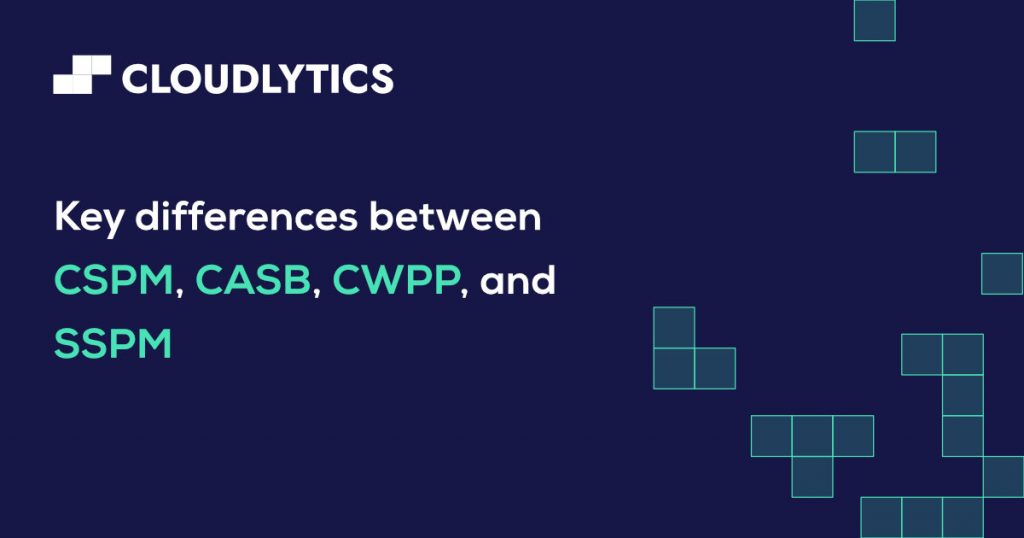Gartner states that public cloud spending will grow 23.1% globally in 2021 to USD 332.3 billion globally, from USD 270 billion in 2020. It further reports that public cloud services remain the most popular, with SaaS (software-as-a-service) touted to reach USD 122.6 billion by the end of 2021.
With cloud adoption, comes security risk.
The recent cloud data breaches have everyone in a fix. Organizations are doubling down on cloud security. It is dominating conversations across organisations. Even in the boardroom!
Cloud security refers to the procedures and technologies that secure the cloud computing environment against internal and external security threats. And ensures adherence to regulatory requirements that differ from one country to another.
Here we will break down the four different cloud security categories – CSPM, CASB, CWPP, and SSPM. And walk you through the key differences that separate them from each other.
Cloud Security Posture Management (CSPM)
Everyone strives to reduce manual errors. But those who are in charge of cloud security understand that the cloud is inherently prone to misconfiguration. Also, with the clouds becoming bigger with every passing day, security becomes that much tougher. Plus, multiple IaaS or SaaS environments compound the configuration challenges.
CSPM or Cloud Security Posture Management is an answer to these cloud security questions that businesses have.
As per Gartner, CSPM refers to a host of security-focussed products and services. These include compliance monitoring, DevOps, and dynamic cloud integration. Enabled through investigation, incident response, risk assessment, and reporting for the cloud control plane.
CSPM protects the workload from the outside by identifying unknown or excessive risk throughout the cloud network. It brings in automation to assess the shortcomings in your security and suggests solutions to remediate the issues.
CSPM helps the organization be proactive, assess risk, reduce misconfiguration, and find ways to ensure their cloud ecosystem employs the highest cloud security measures to keep critical business data safe.
What does CSPM help organizations uncover?
CSPM is the enabler allowing cloud owners to undertake prompt remediation of key security issues. By leveraging the potential of CSPM, companies can unearth policy or security violations such as –
- Lack of encryption
- Misconfigurations
- Permission errors
- Missing multi-factor authentication
- Infrequent encryption key rotation
- Data storage exposed to public
Finding these loopholes helps organizations reduce the chances of a successful cyber-attack and maintain consistency towards security issues.
Key features of CSPM
If you are looking for the right CSPM solution for your cloud security endeavors, here are the features to look for in them –
- Seamless integration with DevOps pipeline stages
- Tools to track activities in real-time
- Limited manual intervention to solve issues at the earliest
- Ability to produce configurable, detailed reporting
- Granular controls
- Ability to assess cloud service provider settings and asset configurations accurately
Usually, Cloud Security Posture Management platforms help Identity and Access Management (IAM) service accounts and APIs to successfully integrate themselves into their client’s ecosystems. These inform organizations of the latest risks, the need to guard against possible breaches, and developing uniform cloud configurations across the board.
Cloud Access Security Broker (CASB)
CASB Definition
A CASB or Cloud Access Security Broker helps protect sensitive data with the help of multiple security policy enforcement consolidations and applying them for safeguarding your critical business data.
A CASB may be software, on-premise, hardware, or cloud-hosted. It acts as a link between users and cloud service providers. It can point out issues across various cloud environments, such as PaaS, SaaS, and IaaS.
What does CASB cover in an organization?
A capable CASB offers the following features for an organization integrating it with their cloud ecosystem-
- Malware detection
- Data loss prevention
- UEBA (User and Entity Behavior Analytics)
- Threat protection
- Cloud governance with risk assessment
- Control over sharing and other native cloud services features
- Auditing configurations
- IAM and SSO integration
- Data encryption and decryption
What are the 4 Pillars of CASB
Here are four pillars of CASB –
Data security
Many brands employ on-premise DLP (data loss prevention) solutions to safeguard their offline data. But given their limitations with respect to managing cloud-based information, combining it with a CASB offers optimum data security. It minimizes data leaks and prevents unwanted access to crucial information.
Threat protection
CASB solutions come with an inbuilt ability to track usage patterns. The presence of machine learning capabilities and UEBA further helps it to detect and troubleshoot threats at the earliest.
Compliance
With CASB’s help, IT managers can figure out the areas of highest risk. It also suggests solutions that would enable the team to help resolve the issues at the earliest.
Visibility
With CASB, companies get insights into cloud app usage and additional information to help track the users. It also undertakes cloud discovery analysis, enabling risk assessment for every cloud service up and running. The granular controls allow better data protection and help businesses optimize their cloud resources by utilizing insights from analyzing individual user data.
Cloud Workload Protection Platform (CWPP)
Today, the business data center is not limited to an on-premise setup but extends to physical, virtual machines (VMs), and IaaS-based setups. Gartner defines a CWPP or Cloud Workload Protection Platform as an agent-based solution that helps address the unique requirements of server workload protection. It is a workload-centric security solution targeting the individual protection requirements in the new-age cloud-heavy organizational environment.
What does CWPP offer for an organization?
A capable CWPP security solution offers the following to an organization integrating it with their existing cloud ecosystem –
- Application control
- Log management and monitoring
- Network segmentation, traffic visibility, and firewalling
- Workload configuration and vulnerability management
- Anti-malware scanning and system integrity management
- HIDS (Host-based Intrusion Detection System) for improved workload behavior monitoring
Benefits of CWPP
Here are the key features of a CWPP solution –
- Ability to scale with the organization with ease
- Allowing brands to respond better and faster to customer queries
- Deriving key insights from applications
- Providing threat and data protection across the board
- Leveraging the user workflows by synthesizing them into an ongoing continuum and reduce management workload
- Focus on the bigger picture i.e. workload management than looking to solve certain aspects i.e. troubleshooting
SaaS Security Posture Management (SSPM)
Gartner defines SSPM or SaaS Security Posture Management as a continuous process of adapting and improvising your cloud security endeavors to reduce the chances of a malicious attack. It is a constant monitoring process overseeing SaaS app environments to determine the measurable difference between the standard security policy and the actual security posture.
SSPM solutions are responsible for running checks on services, such as Slack and Salesforce, beyond the control of the organization and only available on-demand to them. It protects the various elements of the enterprise cloud, such as operating systems, hypervisor, network traffic, and the infrastructure, for ensuring that the customer data is secure and safe.
Why should businesses choose SSPM?
In today’s times, businesses use up to 20 SaaS software for their ecosystem. So it often becomes difficult for the IT team to keep track of the organization’s security risk profile. Adopting an SPPM solution gives them the following advantages –
- Automated real-time remediation of misconfiguration
- Compliance with common standards, such as HIPAA and NIST 800-53
- 24*7 visibility into the plethora of SaaS apps for probable policy violations
80% of cloud breaches will be because of mismanaged credentials or insider thefts and not cloud provider vulnerabilities.
Neil MacDonald, Analyst, Gartner
The 2017 IBM X-Force Report noted a 424% rise in violations related to misconfiguration because of human errors. The inculcation of SSPM enables businesses to handle configuration mistakes and overly scoped permissions better, making it a crucial part of every company’s cloud security endeavours.

Key differences between CSPM, CASB, CWPP, and SSPM
| CSPM | CASB | CWPP | SSPM |
|---|---|---|---|
| Prevents software configuration vulnerabilities | Extends in-house visibility into cloud ecosystems | Performs security functions across a plethora of environments | Manages security shortcomings of SaaS apps integrated into the business ecosystem |
| Automates security and compliance to provide better control over cloud infra configuration | Extends power of the organization over its cloud-based resources, via use of firewalls, DLP, authentication, and web application firewalls | Gives consolidated view and improves visibility across multiple cloud providers in a single console | Offers collection of configurable security controls to manage cloud workloads |
| Primarily used for 1. Identifying vulnerable cloud configuration settings 2. Providing a compliance path for security frameworks 3. Keeping track of every new cloud-based service addition 4. Managing changes made to the logs | Primarily used for 1. Risk assessment, e-discovery, and establishing audit trails for forensic investigation 2. Protecting cloud from compromised accounts, malicious insiders, advanced persistent threats (APTs), and malware 3. Cloud-based compliance 4. Data protection by encryption and key management | Primarily used for 1. Managing cloud vulnerabilities 2. System hardening 3. Micro-segmentation 4. Monitoring system integrity | Primarily used for 1. Strengthening security posture 2. Unified visibility and monitoring of accounts 3. Fixing common application misconfigurations 4. Privilege monitoring |
Cloud security (and all the terms around it :p ) getting too much to handle? Are the breaches all around getting too scary? Have no fear, team Cloudlytics is here 🙂 We are always up for a discussion, a demo or a free trial. Reach out to us here.
Further reading:
- Our e-book on CSPM called ‘A to Z of CSPM’
- Our blog on SaaS Security Posture Management
- Our blog on The Need for Cloud Security Standards
- Our blog on What is SaaS Security?
We send out a monthly newsletter around all things cloud security and CSPM. You can subscribe here.






